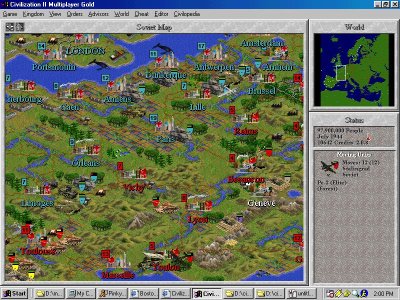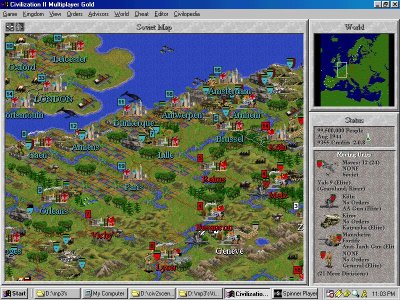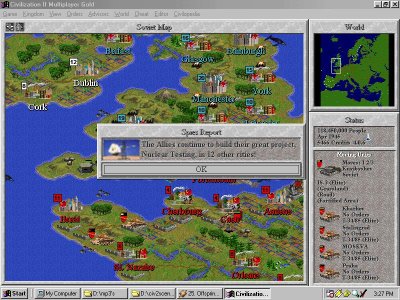PinkyGen
Paper copying intern
Having easily beaten TSFE when having almost a year to prepare for Barbarossa, instead of staring in 1940, I have begun in 1941. Needless to say, we are retreating. 
History of the Great Patriotic War, Chapter 1, The Month of Tragedy, by Geoffrey Hoskings :
Despite signing a treaty a year before with the Soviet Union, Hitler broke his promise and launched a surprising and devastating attack on the motherland on June 7th, 1941.
Soviet troops were caught by surprise and in exposed positions. The Luffwaffle's Heinkels, Stukas, and Me-109's easily outclassed the main fighter, the I-16. Additionally, most of the forward bombing forces were destroyed on the ground in the initial attack. The luffwaffle began bombing forward cities and destroying exposed tanks and infantry. At the same time German Panzers and Waffen SS units began their assault. Two cities were immediatly lost, Brest-Litvosk, and Riga, seizing a majority of the Soviet Union's currency. Strong assaults were also felt in Odessa and surrounding cities, though one KV-1 tank, in a well fortified position was able to destroy some of the enroaching tanks. However, the majority of Soviet armor was caught unaware in the open, and the enemy panzers had a field day.
Comrade Stalin immediatly ordered the conversion of war industries. T-34's were to be the main focus of effort, as this was considered to be the better effective weapon. In fear of air attack, AA batteries were ordered trained, as well as additional I-16's, which while useless for defense, might fair better intercepting the bombers. However, it would be quite a while before production can be brought up to schedule, especially considering the low cash reserves.
Following the initial attack, Soviet forward command structures were paralyzed, so few units were able to receive orders. Unable to redeploy forces, the Red Army would face another month of pure futility in combat. And the Germans would go deeper...
ooc: First turn, and yikes. While perhaps not as scary as the first turn of Red Front (They took how many cities? ) this is still a disaster. My tanks are all exposed, and unable to hit back after the attack. Must be part of the design. The planes are worthless, and their are few AA batteries. Also, the industry is not that great, and the majority of industry is back at the Urals. It will be some time before I can check them.
) this is still a disaster. My tanks are all exposed, and unable to hit back after the attack. Must be part of the design. The planes are worthless, and their are few AA batteries. Also, the industry is not that great, and the majority of industry is back at the Urals. It will be some time before I can check them.

History of the Great Patriotic War, Chapter 1, The Month of Tragedy, by Geoffrey Hoskings :
Despite signing a treaty a year before with the Soviet Union, Hitler broke his promise and launched a surprising and devastating attack on the motherland on June 7th, 1941.
Soviet troops were caught by surprise and in exposed positions. The Luffwaffle's Heinkels, Stukas, and Me-109's easily outclassed the main fighter, the I-16. Additionally, most of the forward bombing forces were destroyed on the ground in the initial attack. The luffwaffle began bombing forward cities and destroying exposed tanks and infantry. At the same time German Panzers and Waffen SS units began their assault. Two cities were immediatly lost, Brest-Litvosk, and Riga, seizing a majority of the Soviet Union's currency. Strong assaults were also felt in Odessa and surrounding cities, though one KV-1 tank, in a well fortified position was able to destroy some of the enroaching tanks. However, the majority of Soviet armor was caught unaware in the open, and the enemy panzers had a field day.
Comrade Stalin immediatly ordered the conversion of war industries. T-34's were to be the main focus of effort, as this was considered to be the better effective weapon. In fear of air attack, AA batteries were ordered trained, as well as additional I-16's, which while useless for defense, might fair better intercepting the bombers. However, it would be quite a while before production can be brought up to schedule, especially considering the low cash reserves.
Following the initial attack, Soviet forward command structures were paralyzed, so few units were able to receive orders. Unable to redeploy forces, the Red Army would face another month of pure futility in combat. And the Germans would go deeper...
ooc: First turn, and yikes. While perhaps not as scary as the first turn of Red Front (They took how many cities?
 ) this is still a disaster. My tanks are all exposed, and unable to hit back after the attack. Must be part of the design. The planes are worthless, and their are few AA batteries. Also, the industry is not that great, and the majority of industry is back at the Urals. It will be some time before I can check them.
) this is still a disaster. My tanks are all exposed, and unable to hit back after the attack. Must be part of the design. The planes are worthless, and their are few AA batteries. Also, the industry is not that great, and the majority of industry is back at the Urals. It will be some time before I can check them.






